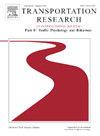Sustainable Steps in the Snow: Exploring factors associated with active school commuting in Finland
IF 3.5
2区 工程技术
Q1 PSYCHOLOGY, APPLIED
Transportation Research Part F-Traffic Psychology and Behaviour
Pub Date : 2024-10-26
DOI:10.1016/j.trf.2024.10.012
引用次数: 0
Abstract
Physical inactivity of children and youth is a major health problem. Active commuting could increase the amount of physical activity and be a more environmentally friendly traffic mode choice compared with motorized vehicles. Parents have an integral role in determining the options a child has for commuting. We explored parental barriers and motivators associated with the active commute of their children.
This cross-sectional study used the CLIMATE NUDGE Survey data of parents with school-aged children. A set of 25 possible influencing factors included demographic factors, social aspects, and pro-environmental attitudes, and questions about the motivating role of journey characteristics and health effects. The data were analyzed with two multinomial logistic regression analyses (N = 320): first, comparing those who either never or sometimes commute actively to those who always do so, and second, those who always or sometimes commute actively to those who never do so.
Results indicated the strongest determinants to differentiate those who always and those who never use active commute, were commute distance and parental beliefs about social commute norms. The longer the commute distance was, the more likely the child was to belong to the never active commuter group and less likely to belong to the always active commuter group. The more parents believed their child’s peers commuted actively, the more likely it was that their child always commuted actively and less likely they never did so.
We found several factors associated with active commuting, yet somewhat surprisingly neither environmental attitudes nor climate change related reasons were significantly associated with active commuting. To conclude, instead of highlighting environmental aspects to promote active commute, we recommend highlighting social norms and perception of the commute distance, and addressing weather-related barriers and health related motivators.
雪中可持续的脚步:探索芬兰学校积极通勤的相关因素
儿童和青少年缺乏运动是一个主要的健康问题。积极的通勤方式可以增加体育活动量,与机动车相比,也是一种更环保的交通方式选择。家长在决定孩子的通勤选择方面发挥着不可或缺的作用。这项横断面研究使用了针对有学龄儿童的家长的 "CLIMATE NUDGE 调查 "数据。一组 25 个可能的影响因素包括人口统计因素、社会方面和环保态度,以及关于旅程特征和健康影响的激励作用的问题。对数据进行了两次多项式逻辑回归分析(N = 320):首先,将从不或有时主动通勤的人与经常主动通勤的人进行比较;其次,将经常或有时主动通勤的人与从不主动通勤的人进行比较。结果表明,区分经常主动通勤和从不主动通勤的人的最强决定因素是通勤距离和父母对社会通勤规范的看法。通勤距离越远,孩子越有可能属于从不主动通勤组,而属于经常主动通勤组的可能性越小。我们发现了一些与积极通勤相关的因素,但令人惊讶的是,无论是环境态度还是气候变化相关原因都与积极通勤没有显著关联。总之,我们建议,与其强调环境因素来促进积极通勤,不如强调社会规范和对通勤距离的认识,并解决与天气相关的障碍和与健康相关的激励因素。
本文章由计算机程序翻译,如有差异,请以英文原文为准。
求助全文
约1分钟内获得全文
求助全文
来源期刊
CiteScore
7.60
自引率
14.60%
发文量
239
审稿时长
71 days
期刊介绍:
Transportation Research Part F: Traffic Psychology and Behaviour focuses on the behavioural and psychological aspects of traffic and transport. The aim of the journal is to enhance theory development, improve the quality of empirical studies and to stimulate the application of research findings in practice. TRF provides a focus and a means of communication for the considerable amount of research activities that are now being carried out in this field. The journal provides a forum for transportation researchers, psychologists, ergonomists, engineers and policy-makers with an interest in traffic and transport psychology.

 求助内容:
求助内容: 应助结果提醒方式:
应助结果提醒方式:


